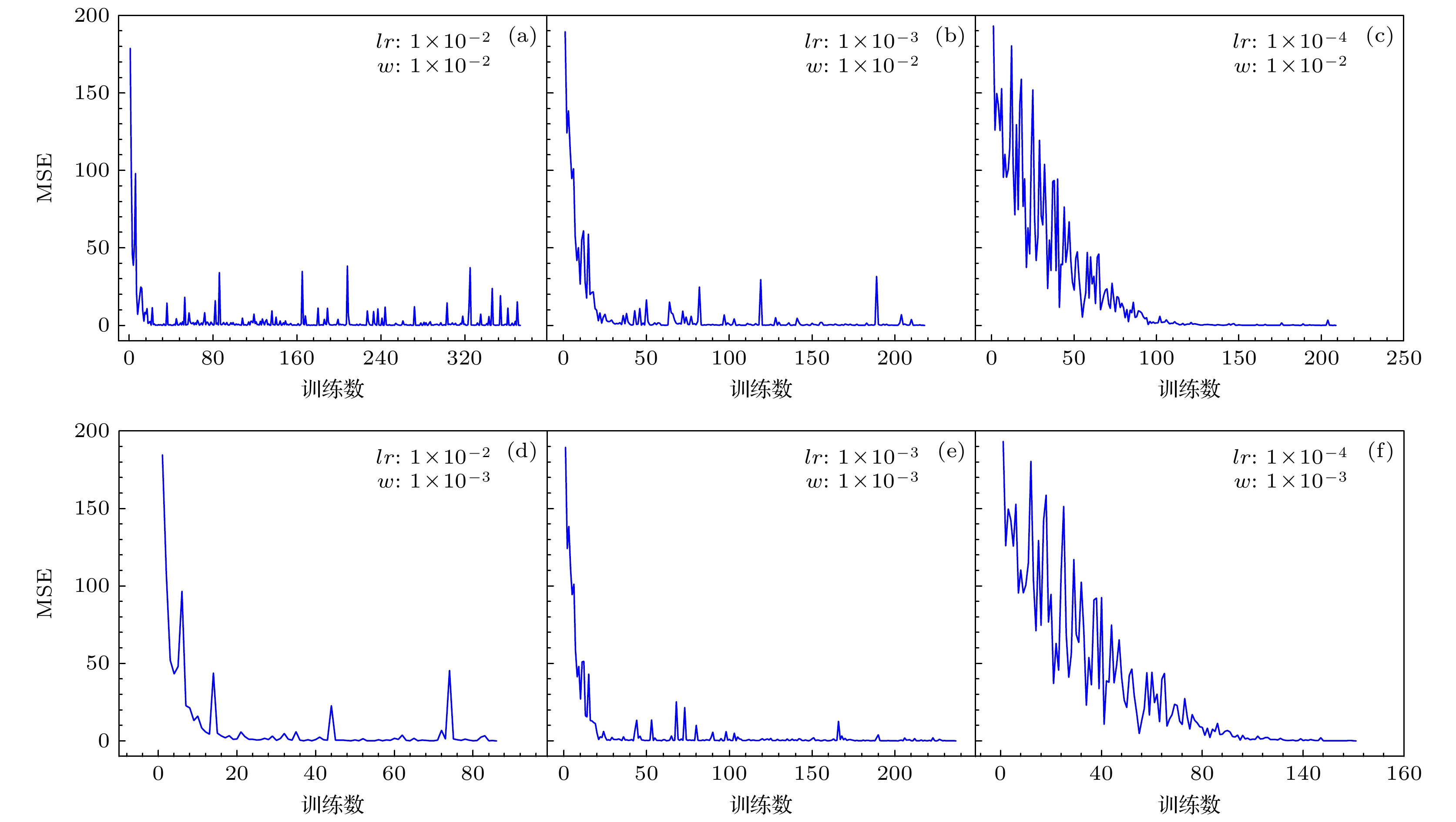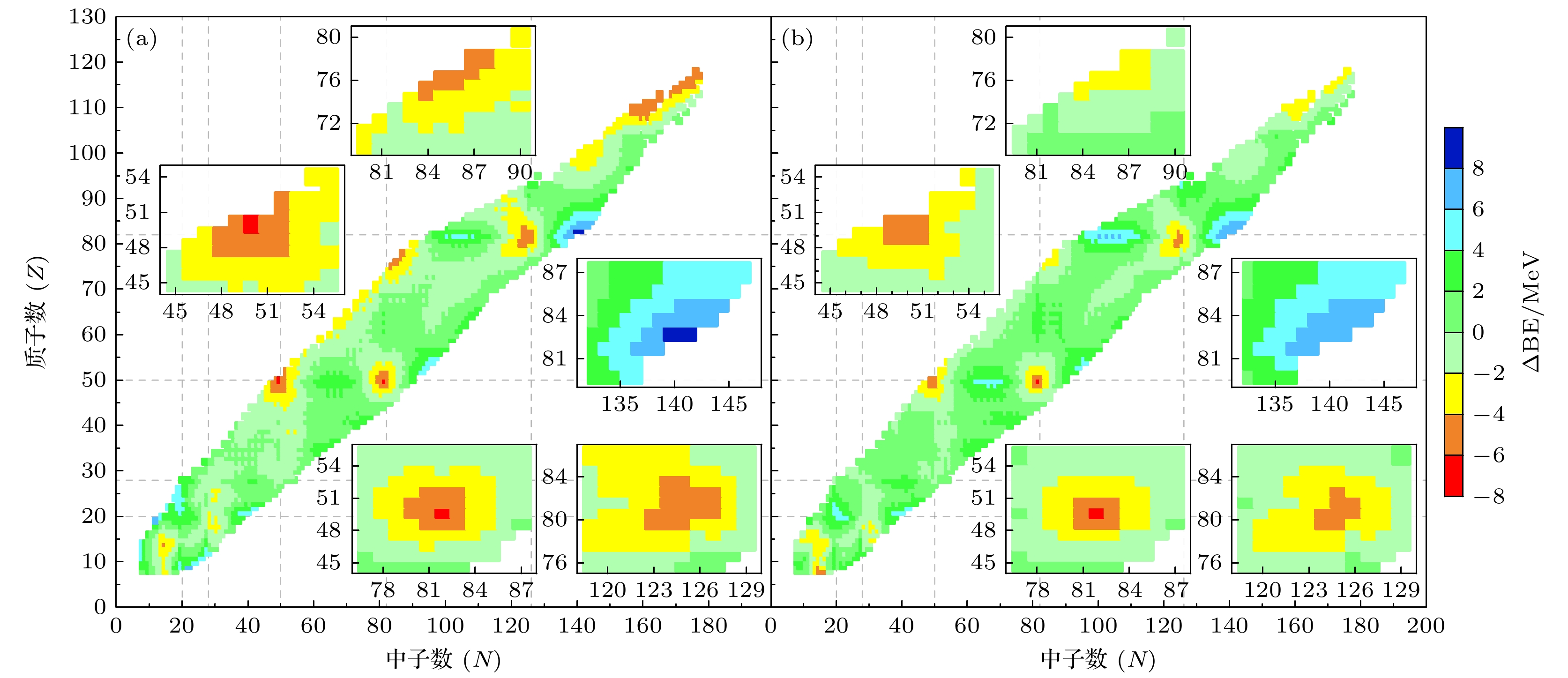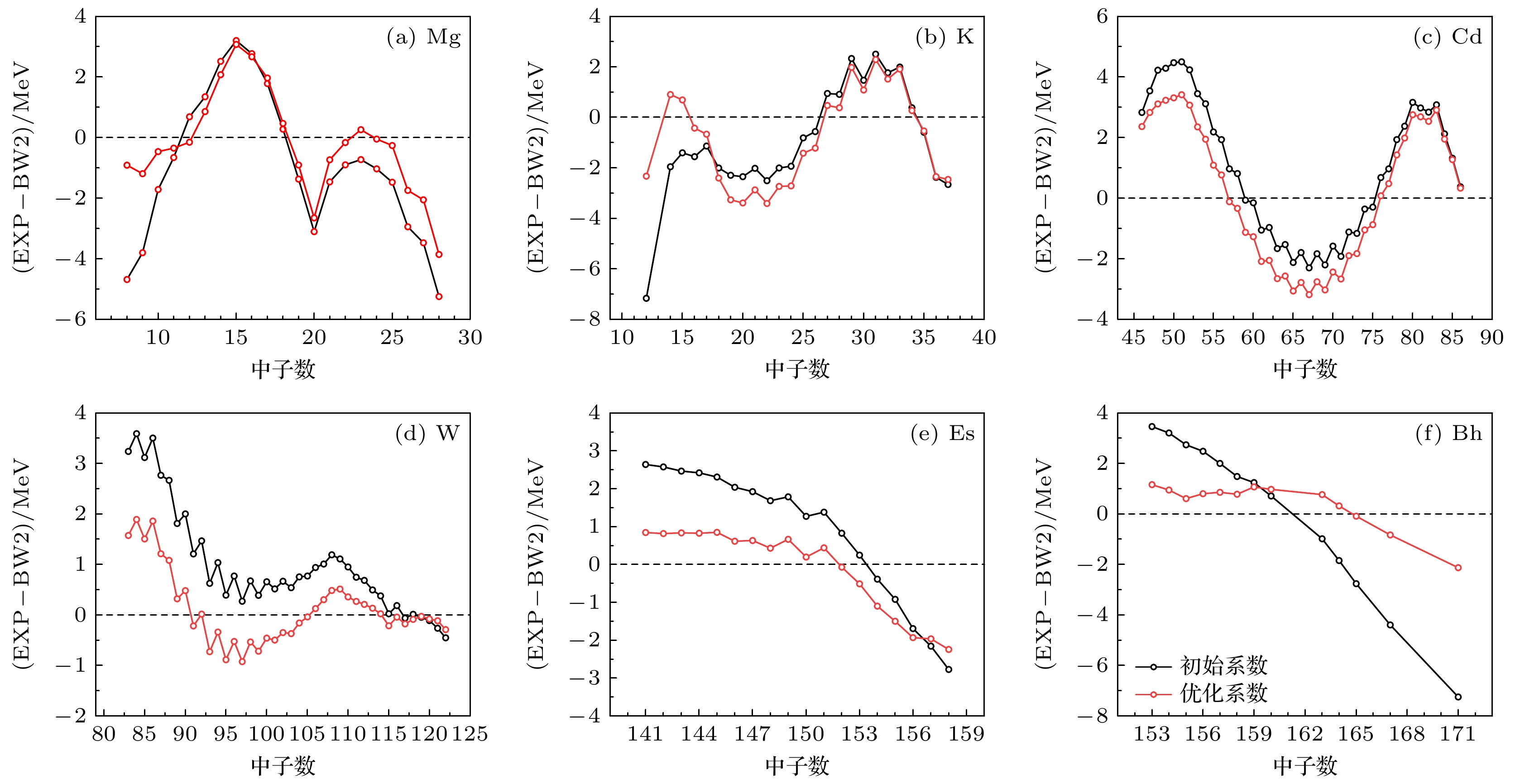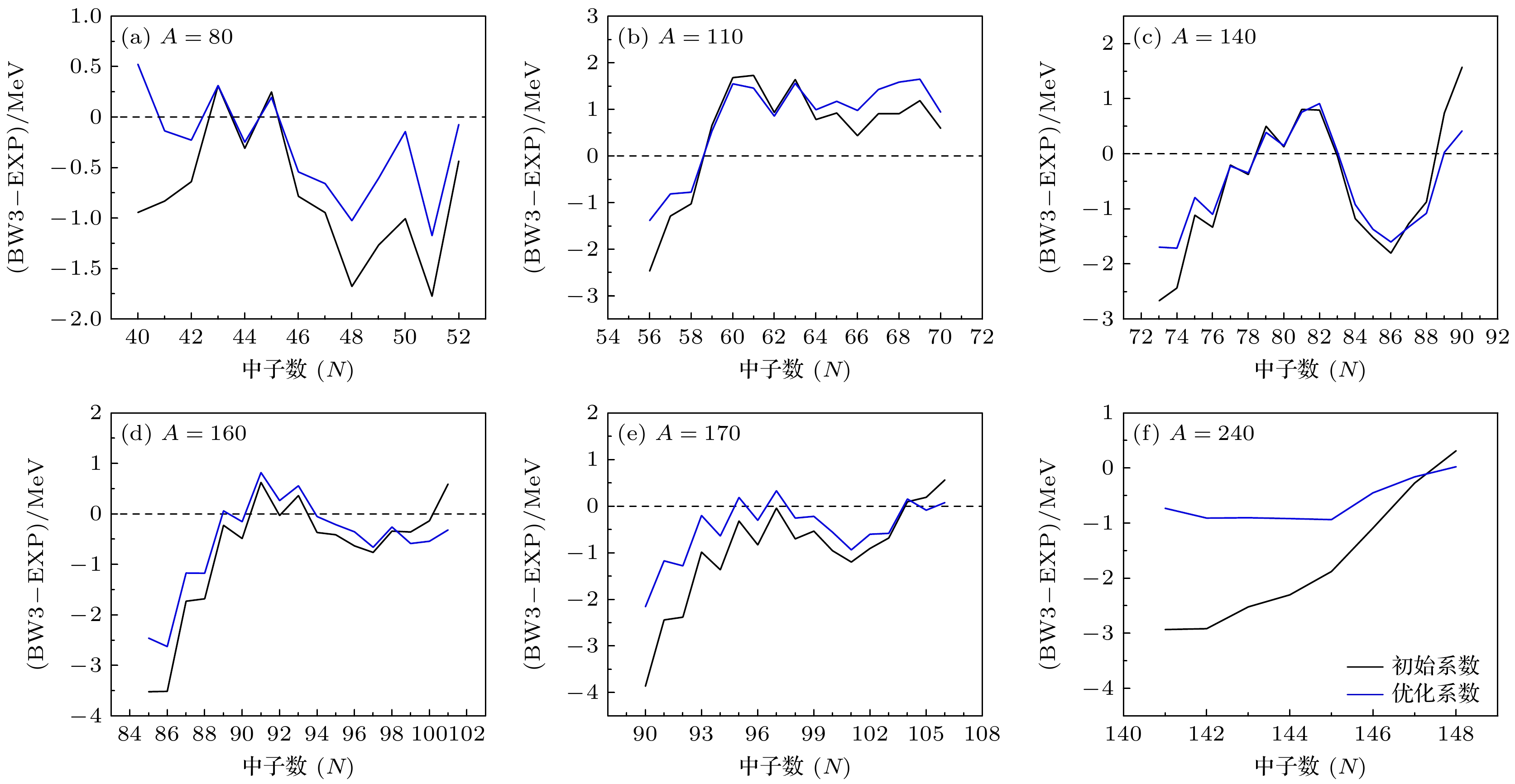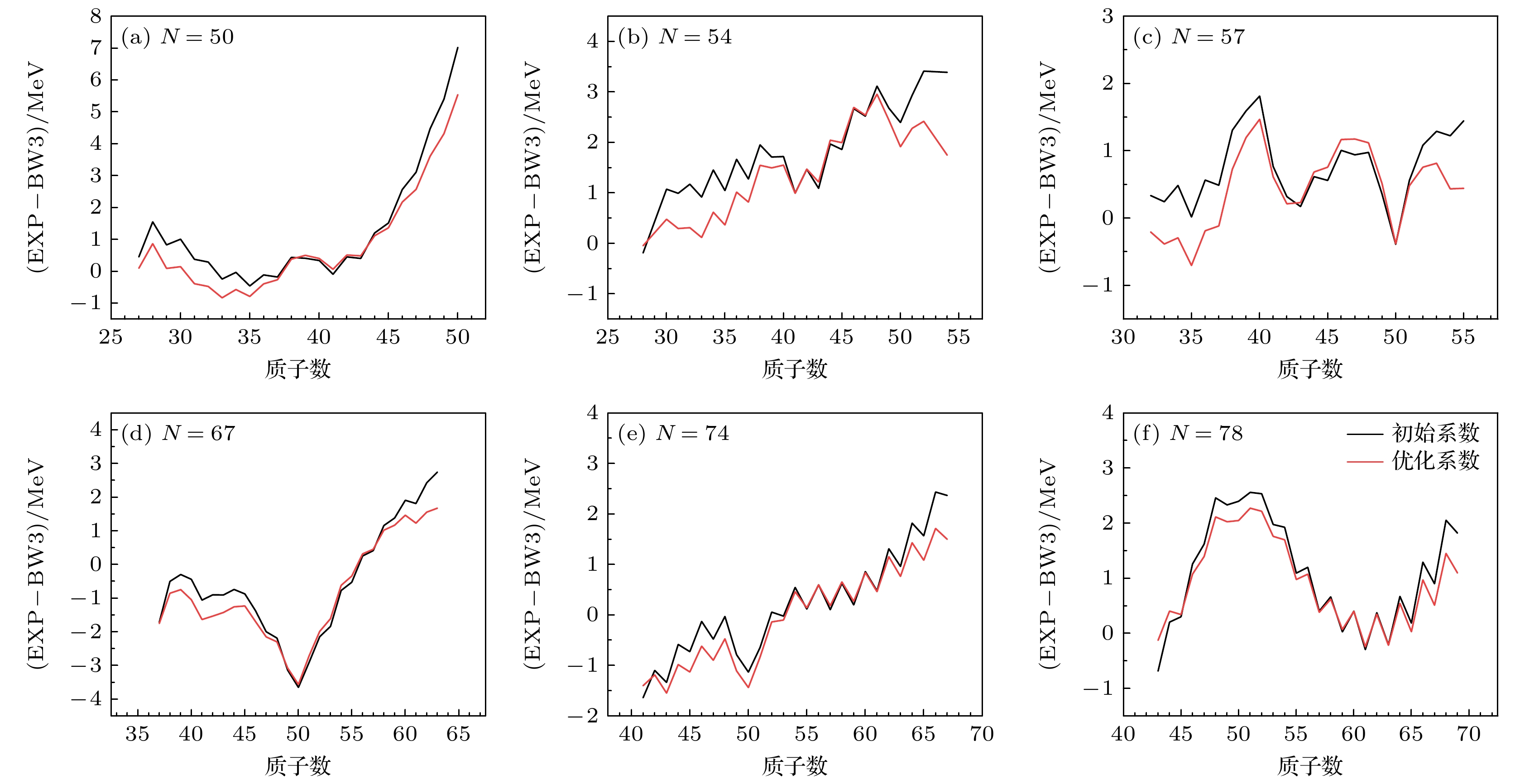-
The nuclear mass model has significant applications in nuclear physics, astrophysics, and nuclear engineering. The accurate prediction of binding energy is crucial for studying nuclear structure, reactions, and decay. However, traditional mass models exhibit significant errors in double magic number region and heavy nuclear region. These models are difficult to effectively describe shell effect and parity effect in the nuclear structure, and also fail to capture the subtle differences observed in experimental results. This study demonstrates the powerful modeling capabilities of MLP neural networks, which optimize the parameters of the nuclear mass model, and reduce prediction errors in key regions and globally. In the neural network, neutron number, proton number, and binding energy are used as training feature values, and the mass-model coefficient is regarded as training label value. The training set is composed of the multiple sets of calculated nuclear mass model coefficients. Through extensive experiments, the optimal parameters are determined to ensure the convergence speed and stability of the model. The Adam optimizer is used to adjust the weight and bias of the network to reduce the mean squared error loss during training. Based on the AME2020 dataset, the trained neural network model with the minimum loss is used to predict the optimal coefficients of the nuclear mass model. The optimized BW2 model significantly reduces root-mean-square errors in double magic number and heavy nuclear regions. Specifically, the optimized model reduces the root-mean-square error by about 28%, 12%, and 18% near Z = 50 and N = 50; Z(N) = 50 and N = 82; Z = 82 and N = 126, respectively. In the heavy nuclear region, the error is reduced by 48%. The BW3 model combines higher-order symmetry energy terms, and after parameter optimization using the neural network, reduces the global root-mean-square error from 1.86 MeV to 1.63 MeV. This work reveals that the model with newly optimized coefficients not only exhibit significant error reduction near double magic numbers, but also shows the improvements in binding energy predictions for both neutron-rich and neutron-deficient nuclei. Furthermore, the model shows good improvements in describing parity effects, accurately capturing the differences related to parity in isotopic chains with different proton numbers. This study demonstrates the tremendous potential of MLP neural networks in optimizing the parameters of nuclear mass model and provides a novel method for optimizing parameters in more complex nuclear mass models. In addition, the proposed method is applicable to the nuclear mass models with implicit or nonlinear relationships, providing a new perspective for further developing the nuclear mass models.
-
Keywords:
- nuclear mass model /
- magic numbers /
- multilayer perceptron neural network /
- Adam optimizer
[1] Lunney D, Pearson J M, Thibault C 2003 Rev. Mod. Phys. 75 1021
 Google Scholar
Google Scholar
[2] 李涛, 黎春青, 周厚兵, 王宁 2021 70 102101
 Google Scholar
Google Scholar
Li T, Li C Q, Zhou H B, Wang N 2021 Acta Phys. Sin. 70 102101
 Google Scholar
Google Scholar
[3] Ramirez E M, Ackermann D, Blaum K, Block M, Droese C, Düllmann C E, Dworschak M, Eibach M, Eliseev S, Haettner E, Herfurth F, Heßberger F P, Hofmann S, Ketelaer J, Marx G, Mazzocco M, Nesterenko D, Novikov Y N, Plaß W R, Rodríguez D, Scheidenberger C, Schweikhard L, Thirolf P G, Weber C 2012 Science 337 1207
 Google Scholar
Google Scholar
[4] Horoi M 2013 International Summer School for Advanced Studies Dynamics of Open Nuclear Systems (Predeal12) Predeal, Romania, July 9–20, 2012 p012020
[5] Wienholtz F, Beck D, Blaum K, Borgmann C, Breitenfeldt M, Cakirli R B, George S, Herfurth F, Holt J D, Kowalska M, Kreim S, Lunney D, Manea V, Menéndez J, Neidherr D, Rosenbusch M, Schweikhard L, Schwenk A, Simonis J, Stanja J, Wolf R N, Zuber K 2013 Nature 498 346
 Google Scholar
Google Scholar
[6] Burbidge E M, Burbidge G R, Fowler W A, Hoyle F 1957 Rev. Mod. Phys. 29 547
 Google Scholar
Google Scholar
[7] Ye W, Qian Y, Ren Z 2022 Phys. Rev. C 106 024318
 Google Scholar
Google Scholar
[8] Bethe H A, Bacher R F 1936 Rev. Mod. Phys. 8 82
 Google Scholar
Google Scholar
[9] Weizsäcker C F V 1935 Zeitschrift für Physik 96 431
 Google Scholar
Google Scholar
[10] Kirson M W 2008 Nucl. Phys. A 798 29
 Google Scholar
Google Scholar
[11] Sorlin O, Porquet M G 2008 Prog. Part. Nucl. Phys. 61 602
 Google Scholar
Google Scholar
[12] Ozawa A, Kobayashi T, Suzuki T, Yoshida K, Tanihata I 2000 Phys. Rev. Lett. 84 5493
 Google Scholar
Google Scholar
[13] Gherghescu R A, Poenaru D N 2022 Phys. Rev. C 106 034616
 Google Scholar
Google Scholar
[14] Björck Å 1990 Handb. Numer. Anal. 1 465
 Google Scholar
Google Scholar
[15] Jiang B N 1998 Comput. Methods Appl. Mech. Eng. 152 239
 Google Scholar
Google Scholar
[16] Mohammed-Azizi B, Mouloudj H 2022 Int. J. Mod. Phys. C 33 2250076
 Google Scholar
Google Scholar
[17] Cao Y, Lu D, Qian Y, Ren Z 2022 Phys. Rev. C 105 034304
 Google Scholar
Google Scholar
[18] Huang W, Wang M, Kondev F, Audi G, Naimi S 2021 Chin. Phys. C 45 030002
 Google Scholar
Google Scholar
[19] Wang M, Huang W, Kondev F, Audi G, Naimi S 2021 Chin. Phys. C 45 030003
 Google Scholar
Google Scholar
[20] Sobiczewski A, Pomorski K 2007 Prog. Part. Nucl. Phys. 58 292
 Google Scholar
Google Scholar
[21] Yin X, Shou R, Zhao Y M 2022 Phys. Rev. C 105 064304
 Google Scholar
Google Scholar
[22] Wang N, Liu M, Wu X 2010 Phys. Rev. C 81 044322
 Google Scholar
Google Scholar
[23] Wu Y C, Feng J W 2018 Wirel. Pers. Commun. 102 1645
 Google Scholar
Google Scholar
[24] Popescu M C, Balas V E, Perescu-Popescu L, Mastorakis N 2009 WSEAS Trans. Cir. and Sys. 8 579
 Google Scholar
Google Scholar
[25] Xiang C, Ding S, Lee T H 2005 IEEE Trans. Neural Netw. 16 84
 Google Scholar
Google Scholar
[26] Pinkus A 1999 Acta Numerica 8 143
 Google Scholar
Google Scholar
[27] Sharma A, Gandhi A, Kumar A 2022 Phys. Rev. C 105 L031306
 Google Scholar
Google Scholar
[28] Wu X H, Ren Z X, Zhao P W 2022 Phys. Rev. C 105 L031303
 Google Scholar
Google Scholar
[29] Gao Z P, Wang Y J, Lü H L, Li Q F, Shen C W, Liu L 2021 Nucl. Sci. Tech. 32 109
 Google Scholar
Google Scholar
[30] 庞龙刚, 周凯, 王新年 2020 原子核物理评论 37 720
 Google Scholar
Google Scholar
Pang L G, Zhou K, Wang X N 2020 Nucl. Phys. Rev. 37 720
 Google Scholar
Google Scholar
[31] Gernoth K A, Clark J W 1995 Neural Networks 8 291
 Google Scholar
Google Scholar
[32] Yüksel E, Soydaner D, Bahtiyar H 2021 Int. J. Mod. Phys. E 30 2150017
 Google Scholar
Google Scholar
[33] Liu M, Wang N, Deng Y, Wu X 2011 Phys. Rev. C 84 014333
 Google Scholar
Google Scholar
[34] Wang N, Liu M 2011 Phys. Rev. C 84 051303
 Google Scholar
Google Scholar
[35] Utama R, Piekarewicz J, Prosper H B 2016 Phys. Rev. C 93 014311
 Google Scholar
Google Scholar
[36] Utama R, Piekarewicz J 2018 Phys. Rev. C 97 014306
 Google Scholar
Google Scholar
[37] Ma C, Zong Y Y, Zhao Y M, Arima A 2020 Phys. Rev. C 102 024330
 Google Scholar
Google Scholar
[38] Özdoğan H, Üncü Y, Şekerci M, Kaplan A 2022 Appl. Radiat. Isot. 184 110162
 Google Scholar
Google Scholar
[39] Chen X, Ma Q, Alkharobi T 2009 2nd IEEE International Conference on Computer Science and Information Technology Beijing, China, August 8–11, 2009 p291
[40] Ming X C, Zhang H F, Xu R R, Sun X D, Tian Y, Ge Z G 2022 Nucl. Sci. Tech. 33 48
 Google Scholar
Google Scholar
[41] Le X K, Wang N, Jiang X 2023 Nucl. Phys. A 1038 122707
 Google Scholar
Google Scholar
[42] Slowik A, Kwasnicka H 2020 Neural Comput. Appl. 32 12363
 Google Scholar
Google Scholar
[43] Amine K 2019 Adv. Oper. Res. 2019 8134674
 Google Scholar
Google Scholar
[44] Wang D, Tan D, Liu L 2018 Soft Computing 22 387
 Google Scholar
Google Scholar
[45] Chen A, Tan H, Zhu Y 2022 2nd International Conference on Applied Mathematics, Modelling, and Intelligent Computing (CAMMIC 2022) Kunming, China, March 25–27, 2022 p1472
[46] Huang L, Qin J, Zhou Y, Zhu F, Liu L, Shao L 2023 IEEE Trans. Pattern Anal. Mach. Intell. 45 10173
 Google Scholar
Google Scholar
[47] Xu X Y, Deng L, Chen A X, Yang H, Jalili A, Wang H K 2024 Nucl. Sci. Tech. 35 91
 Google Scholar
Google Scholar
[48] Möller P, Myers W D, Sagawa H, Yoshida S 2012 Phys. Rev. Lett. 108 052501
 Google Scholar
Google Scholar
[49] Zhang H F, Wang L H, Yin J P, Chen P H, Zhang H F 2017 J. Phys. G: Nucl. Part. Phys. 44 045110
 Google Scholar
Google Scholar
[50] Samyn M, Goriely S, Heenen P H, Pearson J, Tondeur F 2002 Nucl. Phys. A 700 142
 Google Scholar
Google Scholar
[51] Moller P, Nix J, Myers W, Swiatecki W 1995 At. Data Nucl. Data Tables 59 185
 Google Scholar
Google Scholar
[52] Duflo J, Zuker A 1995 Phys. Rev. C 52 R23
 Google Scholar
Google Scholar
-
图 2 Adam优化器不同学习率和权重衰减参数实验对比图, 水平坐标为神经网络训练次数, 垂直坐标为神经网络损失值, 当损失值下降低于0.1%时停止训练($ lr $表示学习率, $ w $表示权重衰减参数)
Figure 2. Comparison chart of Adam optimizer with different learning rates and weight decay parameters. The horizontal axis represents the number of neural network training iterations, and the vertical axis represents the neural network loss value. Training stops when the loss value drops below 0.1%. ($ lr $ represents the learning rate, $ w $ represents the weight decay parameter)
表 1 MLP神经网络寻找的系数组(部分, 单位: MeV)
Table 1. Coefficients identified by the MLP neural network (partial, unit: MeV).
1 2 3 4 5 6 7 8 $ \alpha_{v} $ 16.58 16.22 16.24 16.21 16.22 16.22 16.24 16.05 $ \alpha_{s} $ –26.95 –23.36 –23.42 –23.39 –23.38 –23.36 –23.40 –23.10 $ \alpha_{C} $ –0.77 –0.74 0.74 –0.74 –0.74 –0.75 –0.75 –0.74 $ \alpha_{t} $ –31.51 –31.53 –31.59 –31.54 –31.57 –31.53 –32.60 –31.62 $ \alpha_{xC} $ 2.22 1.39 1.38 1.39 1.40 1.39 1.40 1.59 $ \alpha_{W} $ –43.40 –57.38 –57.40 –57.42 –57.41 –57.40 –57.47 –72.97 $ \alpha_{s t} $ 55.62 54.98 55.02 54.96 55.03 54.99 55.09 64.10 $ \alpha_{p} $ 9.87 10.63 10.61 10.64 10.64 10.63 10.67 10.56 $ \alpha_{R} $ 14.77 9.89 9.94 9.91 9.91 9.89 9.93 9.89 $ \alpha_{m} $ –1.90 –1.89 –1.91 –1.90 –1.89 –1.89 –1.90 –1.88 $ \beta_{m} $ 0.14 0.14 0.13 0.14 0.14 0.15 0.15 0.14 $ b $ — — — — — — — –11.36 $ \sigma $ 1.92 1.90 1.84 1.68 1.76 1.81 1.89 1.63 -
[1] Lunney D, Pearson J M, Thibault C 2003 Rev. Mod. Phys. 75 1021
 Google Scholar
Google Scholar
[2] 李涛, 黎春青, 周厚兵, 王宁 2021 70 102101
 Google Scholar
Google Scholar
Li T, Li C Q, Zhou H B, Wang N 2021 Acta Phys. Sin. 70 102101
 Google Scholar
Google Scholar
[3] Ramirez E M, Ackermann D, Blaum K, Block M, Droese C, Düllmann C E, Dworschak M, Eibach M, Eliseev S, Haettner E, Herfurth F, Heßberger F P, Hofmann S, Ketelaer J, Marx G, Mazzocco M, Nesterenko D, Novikov Y N, Plaß W R, Rodríguez D, Scheidenberger C, Schweikhard L, Thirolf P G, Weber C 2012 Science 337 1207
 Google Scholar
Google Scholar
[4] Horoi M 2013 International Summer School for Advanced Studies Dynamics of Open Nuclear Systems (Predeal12) Predeal, Romania, July 9–20, 2012 p012020
[5] Wienholtz F, Beck D, Blaum K, Borgmann C, Breitenfeldt M, Cakirli R B, George S, Herfurth F, Holt J D, Kowalska M, Kreim S, Lunney D, Manea V, Menéndez J, Neidherr D, Rosenbusch M, Schweikhard L, Schwenk A, Simonis J, Stanja J, Wolf R N, Zuber K 2013 Nature 498 346
 Google Scholar
Google Scholar
[6] Burbidge E M, Burbidge G R, Fowler W A, Hoyle F 1957 Rev. Mod. Phys. 29 547
 Google Scholar
Google Scholar
[7] Ye W, Qian Y, Ren Z 2022 Phys. Rev. C 106 024318
 Google Scholar
Google Scholar
[8] Bethe H A, Bacher R F 1936 Rev. Mod. Phys. 8 82
 Google Scholar
Google Scholar
[9] Weizsäcker C F V 1935 Zeitschrift für Physik 96 431
 Google Scholar
Google Scholar
[10] Kirson M W 2008 Nucl. Phys. A 798 29
 Google Scholar
Google Scholar
[11] Sorlin O, Porquet M G 2008 Prog. Part. Nucl. Phys. 61 602
 Google Scholar
Google Scholar
[12] Ozawa A, Kobayashi T, Suzuki T, Yoshida K, Tanihata I 2000 Phys. Rev. Lett. 84 5493
 Google Scholar
Google Scholar
[13] Gherghescu R A, Poenaru D N 2022 Phys. Rev. C 106 034616
 Google Scholar
Google Scholar
[14] Björck Å 1990 Handb. Numer. Anal. 1 465
 Google Scholar
Google Scholar
[15] Jiang B N 1998 Comput. Methods Appl. Mech. Eng. 152 239
 Google Scholar
Google Scholar
[16] Mohammed-Azizi B, Mouloudj H 2022 Int. J. Mod. Phys. C 33 2250076
 Google Scholar
Google Scholar
[17] Cao Y, Lu D, Qian Y, Ren Z 2022 Phys. Rev. C 105 034304
 Google Scholar
Google Scholar
[18] Huang W, Wang M, Kondev F, Audi G, Naimi S 2021 Chin. Phys. C 45 030002
 Google Scholar
Google Scholar
[19] Wang M, Huang W, Kondev F, Audi G, Naimi S 2021 Chin. Phys. C 45 030003
 Google Scholar
Google Scholar
[20] Sobiczewski A, Pomorski K 2007 Prog. Part. Nucl. Phys. 58 292
 Google Scholar
Google Scholar
[21] Yin X, Shou R, Zhao Y M 2022 Phys. Rev. C 105 064304
 Google Scholar
Google Scholar
[22] Wang N, Liu M, Wu X 2010 Phys. Rev. C 81 044322
 Google Scholar
Google Scholar
[23] Wu Y C, Feng J W 2018 Wirel. Pers. Commun. 102 1645
 Google Scholar
Google Scholar
[24] Popescu M C, Balas V E, Perescu-Popescu L, Mastorakis N 2009 WSEAS Trans. Cir. and Sys. 8 579
 Google Scholar
Google Scholar
[25] Xiang C, Ding S, Lee T H 2005 IEEE Trans. Neural Netw. 16 84
 Google Scholar
Google Scholar
[26] Pinkus A 1999 Acta Numerica 8 143
 Google Scholar
Google Scholar
[27] Sharma A, Gandhi A, Kumar A 2022 Phys. Rev. C 105 L031306
 Google Scholar
Google Scholar
[28] Wu X H, Ren Z X, Zhao P W 2022 Phys. Rev. C 105 L031303
 Google Scholar
Google Scholar
[29] Gao Z P, Wang Y J, Lü H L, Li Q F, Shen C W, Liu L 2021 Nucl. Sci. Tech. 32 109
 Google Scholar
Google Scholar
[30] 庞龙刚, 周凯, 王新年 2020 原子核物理评论 37 720
 Google Scholar
Google Scholar
Pang L G, Zhou K, Wang X N 2020 Nucl. Phys. Rev. 37 720
 Google Scholar
Google Scholar
[31] Gernoth K A, Clark J W 1995 Neural Networks 8 291
 Google Scholar
Google Scholar
[32] Yüksel E, Soydaner D, Bahtiyar H 2021 Int. J. Mod. Phys. E 30 2150017
 Google Scholar
Google Scholar
[33] Liu M, Wang N, Deng Y, Wu X 2011 Phys. Rev. C 84 014333
 Google Scholar
Google Scholar
[34] Wang N, Liu M 2011 Phys. Rev. C 84 051303
 Google Scholar
Google Scholar
[35] Utama R, Piekarewicz J, Prosper H B 2016 Phys. Rev. C 93 014311
 Google Scholar
Google Scholar
[36] Utama R, Piekarewicz J 2018 Phys. Rev. C 97 014306
 Google Scholar
Google Scholar
[37] Ma C, Zong Y Y, Zhao Y M, Arima A 2020 Phys. Rev. C 102 024330
 Google Scholar
Google Scholar
[38] Özdoğan H, Üncü Y, Şekerci M, Kaplan A 2022 Appl. Radiat. Isot. 184 110162
 Google Scholar
Google Scholar
[39] Chen X, Ma Q, Alkharobi T 2009 2nd IEEE International Conference on Computer Science and Information Technology Beijing, China, August 8–11, 2009 p291
[40] Ming X C, Zhang H F, Xu R R, Sun X D, Tian Y, Ge Z G 2022 Nucl. Sci. Tech. 33 48
 Google Scholar
Google Scholar
[41] Le X K, Wang N, Jiang X 2023 Nucl. Phys. A 1038 122707
 Google Scholar
Google Scholar
[42] Slowik A, Kwasnicka H 2020 Neural Comput. Appl. 32 12363
 Google Scholar
Google Scholar
[43] Amine K 2019 Adv. Oper. Res. 2019 8134674
 Google Scholar
Google Scholar
[44] Wang D, Tan D, Liu L 2018 Soft Computing 22 387
 Google Scholar
Google Scholar
[45] Chen A, Tan H, Zhu Y 2022 2nd International Conference on Applied Mathematics, Modelling, and Intelligent Computing (CAMMIC 2022) Kunming, China, March 25–27, 2022 p1472
[46] Huang L, Qin J, Zhou Y, Zhu F, Liu L, Shao L 2023 IEEE Trans. Pattern Anal. Mach. Intell. 45 10173
 Google Scholar
Google Scholar
[47] Xu X Y, Deng L, Chen A X, Yang H, Jalili A, Wang H K 2024 Nucl. Sci. Tech. 35 91
 Google Scholar
Google Scholar
[48] Möller P, Myers W D, Sagawa H, Yoshida S 2012 Phys. Rev. Lett. 108 052501
 Google Scholar
Google Scholar
[49] Zhang H F, Wang L H, Yin J P, Chen P H, Zhang H F 2017 J. Phys. G: Nucl. Part. Phys. 44 045110
 Google Scholar
Google Scholar
[50] Samyn M, Goriely S, Heenen P H, Pearson J, Tondeur F 2002 Nucl. Phys. A 700 142
 Google Scholar
Google Scholar
[51] Moller P, Nix J, Myers W, Swiatecki W 1995 At. Data Nucl. Data Tables 59 185
 Google Scholar
Google Scholar
[52] Duflo J, Zuker A 1995 Phys. Rev. C 52 R23
 Google Scholar
Google Scholar
Catalog
Metrics
- Abstract views: 793
- PDF Downloads: 24
- Cited By: 0
















 DownLoad:
DownLoad:
